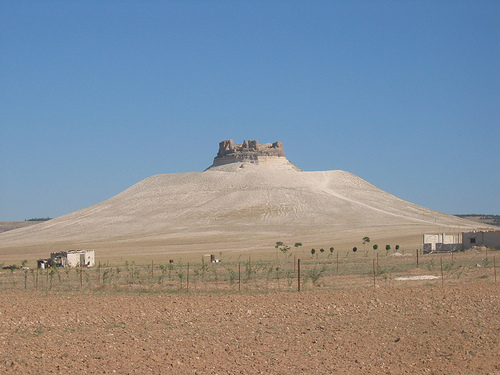

Location: 30 km South-east of Hama Map
Found: 1st century BC by Arab dynasty of Sempsigerami
Shmemis or ash- Shmemis is a ruined ancient fortress situated 30 km South-east of Hama and 5 km North- west of Salamiyah in Syria. Shmemis was constructed in the 1st century BC by Sampsiceramus I, the first Priest King of the Royal family of Emesa that is also known as the Sampsiceramids. Although first settlement on this location was first established during Bronze Age in 14th century BC. A site for Shmemis was chosen on a site of an extinct volcano. It was captured and demolished by the Persian king Khosrau in 613 AD. Citadel defensive walls and towers were further damaged by an earthquake of 1157. It was reconstructed in 1229 by Assad ud- Din Shirkoh, an Ayyubid governor of Homs to defend against the Crusaders, but new Shmemis stronghold didn't last too long. It was demolished by the Mongols in 1260 and again in 1401 by Mongol tribe of Tatars. Shmemis was partially reconstructed by Baybars I (Sultan of Mamluks) in 1260 after the invasions died out. It is not entirely known how long did Shmemis castle retained its military function. Today it is mostly abandoned and ruined due to natural erosion.
Schmemis is located about 25 kilometers southeast of Hama on the edge of the Syrian desert steppe and rises about 150 meters above the plain on an old, 636-meter-high volcanic cone. The castle ruins are 5 kilometers away from Salamiyya and can be reached from the end of the town towards Hama on an asphalt side road branching off to the north. The grain fields of the plain extend to the foot of the stony, vegetation-free hill. There are a number of similarly high hill ranges in the surrounding area, some of which are being reforested.
The earliest excavation finds on the hill date back to the Bronze Age
in the 14th century BC. Dated. In Roman times, foggaras were built to
supply water.
Salamiyya and the surrounding area was the center
of the Ismailis from the 8th century to around 900. An earlier facility
was destroyed in an earthquake in 1157. The castle was built around 1230
by the Ayyubid prince Malik al-Mujtahin Shirkuh of Homs. After several
victories of the Ayyubid Sultan as-Salih against the Crusaders, he took
possession of the castle in 1245. It was destroyed by the Mongols around
1260. Baibars I, Sultan of the Mamelukes from 1260, took over the castle
and ordered its reconstruction.
How long the castle retained its
function is unclear. The area was hardly populated in the Middle Ages.
In the 17th century, the Druze emir Fakhr ad-Dīn II (r. 1585–1633)
expanded his principality via Schmemis to Palmyra, where he also
occupied the local Mamluk fortress of Qal'at Ibn Ma'n.
The area
was not populated again until the middle of the 19th century, when the
Ottoman leadership allowed the Ismailis who had fled during the Mongol
invasion to return. The starting point for the repopulation of the
castle ruins was a dispute that broke out in 1843 between the then
governor of Masyaf in Jebel Ansariye and two renegade Ismaili leaders. A
member of a prominent Sunni family was killed in the power struggle that
took place in nearby Qadmus. Of the two insurgents, one was caught and
killed while fleeing; the other, Isma'il, retreated to a mountain
village. In 1847 or 1848, a commander in the Ottoman army granted
Isma'il amnesty on the condition that he and his followers retreat to an
area east of the Orontes. A document from the Ottoman Sultan Abdülmecid
I from July 1849 is said to have allowed them to establish a settlement
on the edge of the desert and to arm 40 men to defend the place. The
settlers were exempt from conscription and taxes. Isma'il chose
Salamiyya as the place of settlement. The approximately 90 emigrants
from 16 families mostly belonged to the Hajjawis, one of the two main
groups of Syrian Ismailis who split off around the 16th century.
Initially they lived in the castle ruins, from where they began to
create farmland and put the Roman foggaras back into use. They often had
to protect their fields and flocks of sheep from raids by several
Bedouin tribes. Although each settler was given as much land as he
wanted, the colony grew slowly until the end of the 19th century.
From the distance you can see the vertical rock walls, below which a trench was cut all around for defense purposes. The walls were made of double-shell basalt blocks and filled with cast masonry on the inside. Only small remains of the outer fortress wall remain. A special feature is a deep cistern shaft with a diameter of five meters, which was carved out of the rock in the southern, lower part.